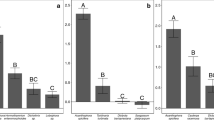Abstract
The ecology, defensive behavior and toxicity of three species of reef flat holothurians (Actinopyga mauritiana, Holothuria atra and Holothuria difficilis) were studied at Eniwetok Atoll, Marshall Islands. The average diurnal population density of H. difficilis ranged from 1.4 to 32 holothurians/900 cm2; resting respiratory rates (0.05 ml O2/g wet wt/h) were comparable during day and night; nourishment in H. difficilis may be primarily from bacteria and foraminifera in which about 2% of the dry weight of sediment consumed is utilized, and the species probably passes at least 3 g dry wt of sediment/m2/day (>1 kg/m2/year). A fundamental difference in energy flow is suggested: considerably more energy is passed from benthic algae to grazing and browsing fishes to predatory fishes on coral reefs whereas, in extra-tropical latitudes, more energy is shunted from benthic algae to invertebrates to predators. The effects of holothurin leading to death in fishes are irreversible. Holothuria difficilis is best protected from predation. Its body wall is toxic and it can accurately eject Cuvierian tubules, which are also toxic. The discharge of tubules was regulated by a circadian rhythm in May. Studies on holothurians and sponges suggest that many exposed coral reef invertebrates have evolved effective defensive mechanisms in association with high intensity predation.
Similar content being viewed by others
Literature cited
Bakus, G. J.: The effects of fish-grazing on invertebrate evolution in shallow tropical waters. Occ. Pap. Allan Hancock Fdn 27, 1–29 (1964).
—: Some relationships of fishes to benthic organisms on coral reefs. Nature, Lond. 210, 280–284 (1966).
—: The feeding habits of fishes and primary production at Eniwetok, Marshall Islands. Micronesica 3, 135–149 (1967).
Bonham, K. and E. E. Held: Ecological observations on the sea cucumbers Holothuria atra and H. leucospilota at rongelap Atoll, Marshall Islands. Pacif. Sci. 17, 305–314 (1963).
Domantay, J. S.: Littoral Holothuroidea of Hundred Islands and vicinity, Lingayen Gulf, Luzon Island, Philippines. Philipp. J. Sci. 89, 79–108 (1960).
Farmanfarmaian, A.: The respiratory physiology of echinoderms. In: Physiology of echinodermata, pp 245–266. Ed. by R. A. Boolootian. New York: Interscience 1966.
Halstead, B.: Poisonous and venomous marine animals of the world. Vol. 1, Invertebrates, 994 pp. Washington: U.S. Govt. 1965.
Hiatt, R. W. and D. W. Strasburg: Ecological relationships of the fish fauna on coral reefs of the Marshall Islands. Ecol. Monogr. 30, 65–127 (1960).
Hobson, E. S.: Diurnal-nocturnal activity of some inshore fishes in the Gulf of California. Copeia No. 3, 291–302 (1965).
Hyman, H. L.: The invertebrates. Vol. 4, Echinodermata, 763 pp. New York: McGraw-Hill 1955.
Nigrelli, R. F. and S. Jakowska: Effects of holothurin, a steroid saponin from the Bahamian sea cucumber (Actinopyga agassizi), on various biological systems. Ann. N.Y. Acad. Sci. 90, 884–892 (1960).
Nikolsky, G.: The ecology of fishes, 352 pp. New York: Academic Press 1963.
Pawson, D. L.: Ecology of holothurians. In: Physiology of echinodermata, pp 63–72. Ed. by R. A. Boolotian. New York: Interscience 1966.
Phleger, F. B.: Ecology and distribution of recent foraminifera, 297 pp. Baltimore: Johns Hopkins 1960.
Prosser, C. L. and F. A. Brown, Jr.: Comparative animal physiology, 688 pp. Philadelphia: Saunders 1961.
Russell, E.: An investigation of the palatability of some marine invertebrates to four species of fish. Pacif. Sci. 20, 452–460 (1966).
Starck, W. A. II and W. P. Davis: Night habits of fishes of Alligator Reef, Florida. Ichthyologica 38, 313–356 (1966).
Wood, E. J. F.: Marine microbial ecology, 243 pp. New York: Reinhold 1965.
Yamanouchi, T.: On the poisonous substance contained in holothurians. Publs Seto mar. biol. Lab. 4, 184–202 (1955).
Yamanouti, T.: Ecological and physiological studies on the holothurians in the coral reef of Palao Islands. Palao trop. biol. Stn Stud. 4, 605–635 (1939).
Author information
Authors and Affiliations
Additional information
Communicated by G. L. Voss, Miami
Supported by A.E.C. Contract AT (29-2)-226 with the University of Hawaii.
Rights and permissions
About this article
Cite this article
Bakus, G.J. Defensive mechanisms and ecology of some tropical holothurians. Marine Biol. 2, 23–32 (1968). https://doi.org/10.1007/BF00351634
Accepted:
Issue Date:
DOI: https://doi.org/10.1007/BF00351634




